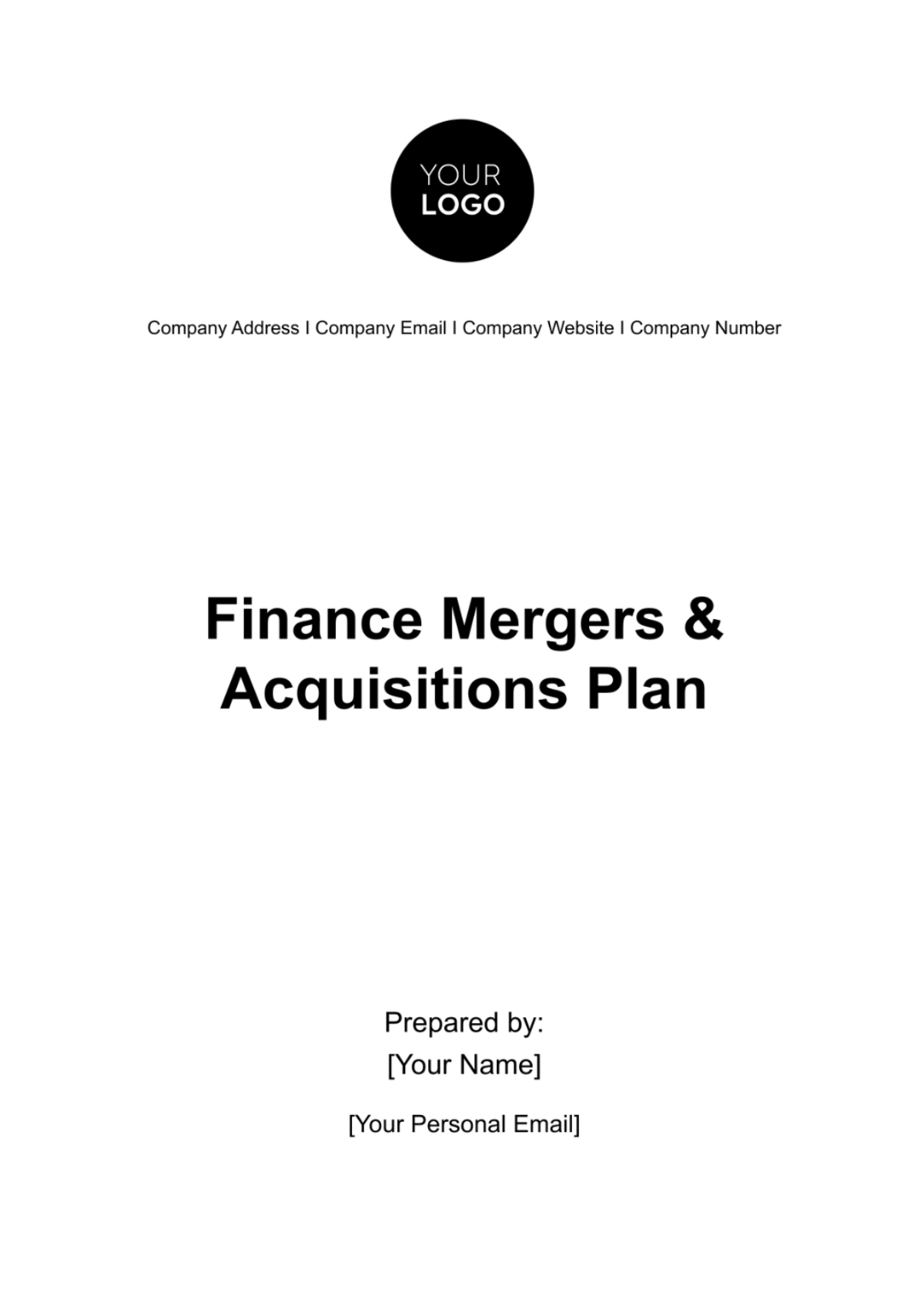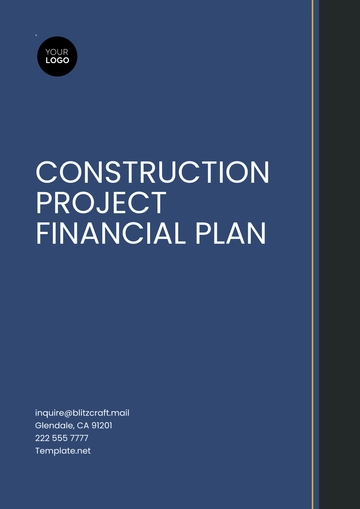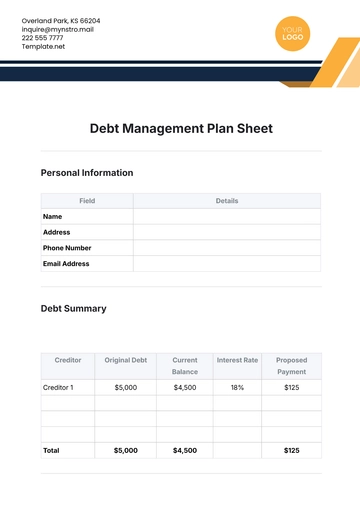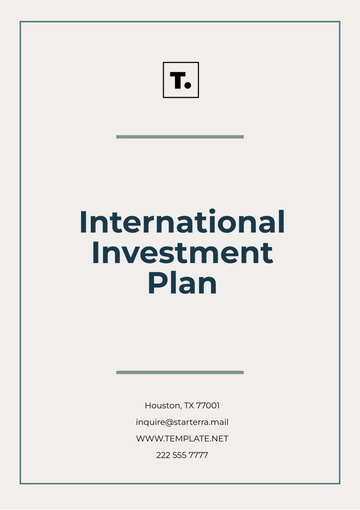Free Finance Mergers & Acquisitions Plan

I. Executive Summary
Overview:
This Finance Mergers & Acquisitions Plan outlines [Your Company Name]'s strategic move to acquire [Your Partner Company Name / Second Party], a leading software development company. The initiative is rooted in [Your Company Name]'s commitment to diversify its product portfolio and fortify its position in the dynamic technology sector. By combining [Your Company Name]'s hardware expertise with [Your Partner Company Name / Second Party]'s innovative software solutions, the merged entity aims to offer comprehensive, integrated offerings to clients, fostering growth and sustainability in a rapidly evolving market.
Key Highlights:
The acquisition promises significant advantages, including a diversified product line, expanded market reach, and an anticipated [0]% reduction in operational costs through synergies. [Your Company Name] expects to enhance its competitive edge, tap into new revenue streams, and solidify its presence in emerging technology markets.
II. Introduction
Background:
[Your Company Name], a trailblazer in technology solutions, recognizes the strategic importance of acquiring [Your Partner Company Name / Second Party] With a history of successful innovation, [Your Partner Company Name / Second Party] complements [Your Company Name]'s goals by bringing cutting-edge software development capabilities to the table. The acquisition aligns with [Your Company Name]'s commitment to staying at the forefront of technological advancements and ensuring sustained growth in an ever-changing business landscape.
Industry Overview:
In the context of the technology industry, where agility and innovation are paramount, the acquisition positions [Your Company Name] to meet the rising demand for integrated solutions. The software development expertise of [Your Partner Company Name / Second Party] strategically aligns with market trends, allowing the merged entity to address evolving customer needs and maintain a competitive edge in the industry.
III. M&A Strategy
Objectives:
The overarching objectives of the M&A strategy are to expand [Your Company Name]'s product offerings, leverage synergies for enhanced research and development capabilities, and increase market share in the software development sector. By integrating [Your Partner Company Name / Second Party]'s specialized software solutions, [Your Company Name] aims to create a holistic technological ecosystem that caters to a broader client base and anticipates future industry demands.
Rationale:
The rationale behind acquiring [Your Partner Company Name / Second Party] lies in the unique strengths each company brings to the table. [Your Partner Company Name / Second Party]'s advanced software solutions complement [Your Company Name]'s hardware prowess, creating a synergy that fosters innovation, accelerates time-to-market, and positions the merged entity as a comprehensive technology solutions provider capable of addressing the entire spectrum of client needs.
IV. Financial Analysis
Target Company Financials:
[Your Partner Company Name / Second Party]'s impressive historical performance, characterized by a consistent [0]% annual growth rate and a substantial increase in net income, underscores its financial stability and growth potential. This robust financial track record forms a solid foundation for the merged entity's anticipated financial strength.
Projections:
The financial projections for the combined entity showcase a compelling narrative of growth, with an estimated [0]% increase in revenue over the next two years. The synergy-driven forecasts also predict a substantial [0]% rise in EBITDA, reinforcing the financial viability and potential profitability of the merger.
V. Valuation
Methods:
Utilizing a comprehensive valuation approach, including Discounted Cash Flow (DCF) analysis, Comparable Company Analysis (CCA), and Precedent Transactions, the fair market value determination of $[0] billion reflects a thorough and balanced assessment of [Your Partner Company Name / Second Party]'s intrinsic value and future potential within the context of the industry landscape.
Fair Market Value:
The valuation outcome indicates a fair market value with a [0]% premium over [Your Partner Company Name / Second Party]'s current market value, taking into consideration the strategic advantages and growth prospects associated with the merger.
VI. Deal Structure
Overview:
To facilitate a seamless transition and preserve [Your Partner Company Name / Second Party]'s existing contracts and partnerships, the proposed deal structure involves a stock purchase. This approach aligns with the strategic objectives of both companies and provides a framework for the efficient transfer of ownership, minimizing disruption to ongoing operations.
Tax Implications:
A meticulous consideration of tax implications guides the deal structuring process. The chosen stock purchase structure not only ensures a smooth transition but also aims to optimize the combined entity's tax position, aligning with [Your Company Name]'s overall financial strategy and preserving shareholder value.
VII. Financing Strategy
Sources:
[Your Company Name] plans to fund the acquisition through a combination of internal resources and debt financing. With substantial cash reserves of $[0] billion, the company aims to utilize a prudent mix of equity and debt, ensuring a balanced capital structure. Negotiations are already underway with reputable financial institutions to secure favorable terms for the debt financing component, aligning with [Your Company Name]'s commitment to optimizing its cost of capital.
Terms:
The financing terms are structured to provide flexibility and financial sustainability. [Your Company Name] is actively exploring options for long-term debt with competitive interest rates, enabling the company to maintain financial stability while successfully executing the acquisition. The proposed capital structure post-acquisition reflects a careful consideration of risk and return, ensuring optimal utilization of financial resources.
VIII. Risk Assessment
Identified Risks:
In-depth risk assessment has identified potential challenges, including integration complexities, regulatory hurdles, and uncertainties in the market landscape. Recognizing these risks, the M&A team has developed comprehensive mitigation strategies to address each challenge systematically and minimize any adverse impact on the success of the acquisition. Proactive risk management is integral to the overall strategy, ensuring a resilient approach to potential obstacles.
Mitigation Strategies:
To mitigate integration challenges, a detailed integration plan has been developed, outlining clear milestones and responsibilities. The legal team is collaborating closely to navigate regulatory compliance, and scenario planning is in place to address potential market fluctuations. Continuous monitoring and adaptation of risk mitigation strategies will be crucial throughout the M&A process, ensuring agility in response to changing circumstances.
IX. Due Diligence Findings
The due diligence process has yielded favorable findings, affirming [Your Partner Company Name / Second Party]'s robust intellectual property portfolio, sound financial health, and minimal legal or operational red flags. This comprehensive due diligence ensures that all aspects crucial to the success of the M&A transaction have been thoroughly examined and align with the initial assessments. The positive due diligence outcomes strengthen the confidence in the strategic fit and overall viability of the acquisition.
X. Synergy Analysis
Identified Synergies:
Through a detailed synergy analysis, the M&A team has identified several key areas for synergy realization. Shared research and development capabilities between [Your Company Name] and [Your Partner Company Name / Second Party] are expected to accelerate innovation. Cross-selling opportunities in existing client bases promise revenue enhancements, while operational efficiencies are projected to result in substantial cost savings. The synergies form the foundation for the strategic benefits of the acquisition, promising a holistic integration that maximizes value for stakeholders.
Integration Benefits:
Anticipated cost savings of $[0] million annually are expected to result from streamlined operations, consolidated resources, and optimized workflows. Beyond financial gains, the integration benefits encompass enhanced collaborative capabilities, positioning the merged entity as a formidable force in the technology sector. The integration plan has been meticulously crafted to ensure a smooth and efficient transition, maximizing the realization of identified synergies.
XI. Legal Considerations
Regulatory Compliance:
Thorough legal considerations include a comprehensive review of regulatory requirements to ensure seamless compliance throughout the M&A process. The legal team is actively engaged in addressing any potential legal hurdles, safeguarding the interests of both [Your Company Name] and [Your Partner Company Name / Second Party] A proactive and transparent approach to regulatory compliance is paramount, minimizing the risk of legal challenges post-acquisition.
Legal Due Diligence Findings:
Legal due diligence has revealed a clean bill of health, with no material legal issues identified that could impede the progress of the acquisition. [Your Partner Company Name / Second Party]'s adherence to legal standards and regulations further strengthens the legal foundation of the transaction, contributing to a smooth and legally sound integration process.
XII. Human Resources Considerations
Workforce Assessment:
An in-depth assessment of [Your Partner Company Name / Second Party]'s workforce has been conducted to identify key talents and ensure a smooth transition. Employee skills, competencies, and cultural fit have been evaluated, forming the basis for strategic decisions on talent retention and human resources integration.
Employee Benefits and Retention:
To ensure the retention of key talents, an attractive employee benefits package and retention incentives have been developed. The objective is to create a positive and motivating environment, aligning the interests of the existing workforce with the goals of the merged entity.
Integration Plan for Human Resources:
A comprehensive integration plan for human resources outlines the steps for harmonizing organizational cultures, aligning compensation and benefits structures, and facilitating open communication. The focus is on creating a unified and collaborative workplace that fosters innovation and maximizes the potential of the combined workforce.
XIII. Integration Plan
Detailed Plan:
The integration plan outlines a phased approach to combining [Your Company Name] and [Your Partner Company Name / Second Party], emphasizing a systematic and collaborative process. Key milestones include the consolidation of technology infrastructure, the alignment of operational processes, and the integration of research and development teams. A dedicated integration team will oversee the execution of the plan, ensuring a smooth and efficient transition.
Timeline:
The integration timeline spans over 18 months, allowing for careful planning and execution of each integration phase. Early integration activities will focus on technology alignment, followed by a gradual merging of operational functions, culminating in the full integration of teams and systems. This phased approach aims to minimize disruption to ongoing operations while maximizing the realization of synergies.
XIV. Approval Process
Stakeholder Approval:
The approval process involves seeking consent from various stakeholders, including shareholders, regulatory bodies, and internal management. A transparent and comprehensive communication strategy is in place to keep stakeholders informed and address any concerns. The goal is to obtain unanimous approval, ensuring a strong mandate for the successful execution of the acquisition.
Regulatory Approval Considerations:
The legal team is actively managing regulatory approval considerations, coordinating with relevant authorities to facilitate a timely approval process. Regular updates will be provided to stakeholders throughout the regulatory review, ensuring transparency and compliance with all regulatory requirements. Contingency plans are in place to address any potential delays or challenges in the approval process.
XV. Communication Plan
Internal Communication:
An internal communication plan has been developed to keep employees informed and engaged throughout the M&A process. Regular town hall meetings, newsletters, and collaborative platforms will facilitate transparent communication, addressing concerns and fostering a sense of unity among the workforce. The emphasis is on maintaining employee morale and productivity during the transition.
External Communication:
Externally, a carefully crafted communication strategy aims to manage the perception of the acquisition positively. Press releases, media briefings, and stakeholder updates will highlight the strategic benefits of the merger, emphasizing the shared vision and enhanced capabilities of the combined entity. The goal is to build confidence among clients, partners, and the broader industry.
XVI. Conclusion
Summary of Key Points:
In conclusion, the Finance Mergers & Acquisitions Plan positions the acquisition of [Your Partner Company Name / Second Party] as a strategic move that aligns with [Your Company Name]'s growth objectives. The plan provides a comprehensive overview of the financial, strategic, and operational considerations, highlighting the potential for synergies and increased competitiveness in the technology sector.
Next Steps:
With stakeholder approval as the immediate focus, the next steps involve the execution of the integration plan and the implementation of synergies outlined in the M&A strategy. The entire team is committed to ensuring a seamless transition and unlocking the full potential of the combined entity, solidifying [Your Company Name]'s position as a leader in the technology industry.
- 100% Customizable, free editor
- Access 1 Million+ Templates, photo’s & graphics
- Download or share as a template
- Click and replace photos, graphics, text, backgrounds
- Resize, crop, AI write & more
- Access advanced editor
Explore the Finance Mergers & Acquisitions Plan Template on Template.net, your key to strategic financial consolidation. This editable and customizable template, powered by an advanced AI Editor Tool, empowers you to navigate mergers seamlessly. Uncover synergies, mitigate risks, and streamline integration effortlessly. Elevate your M&A game with a template that adapts to your unique financial objectives.
You may also like
- Finance Plan
- Construction Plan
- Sales Plan
- Development Plan
- Career Plan
- Budget Plan
- HR Plan
- Education Plan
- Transition Plan
- Work Plan
- Training Plan
- Communication Plan
- Operation Plan
- Health And Safety Plan
- Strategy Plan
- Professional Development Plan
- Advertising Plan
- Risk Management Plan
- Restaurant Plan
- School Plan
- Nursing Home Patient Care Plan
- Nursing Care Plan
- Plan Event
- Startup Plan
- Social Media Plan
- Staffing Plan
- Annual Plan
- Content Plan
- Payment Plan
- Implementation Plan
- Hotel Plan
- Workout Plan
- Accounting Plan
- Campaign Plan
- Essay Plan
- 30 60 90 Day Plan
- Research Plan
- Recruitment Plan
- 90 Day Plan
- Quarterly Plan
- Emergency Plan
- 5 Year Plan
- Gym Plan
- Personal Plan
- IT and Software Plan
- Treatment Plan
- Real Estate Plan
- Law Firm Plan
- Healthcare Plan
- Improvement Plan
- Media Plan
- 5 Year Business Plan
- Learning Plan
- Marketing Campaign Plan
- Travel Agency Plan
- Cleaning Services Plan
- Interior Design Plan
- Performance Plan
- PR Plan
- Birth Plan
- Life Plan
- SEO Plan
- Disaster Recovery Plan
- Continuity Plan
- Launch Plan
- Legal Plan
- Behavior Plan
- Performance Improvement Plan
- Salon Plan
- Security Plan
- Security Management Plan
- Employee Development Plan
- Quality Plan
- Service Improvement Plan
- Growth Plan
- Incident Response Plan
- Basketball Plan
- Emergency Action Plan
- Product Launch Plan
- Spa Plan
- Employee Training Plan
- Data Analysis Plan
- Employee Action Plan
- Territory Plan
- Audit Plan
- Classroom Plan
- Activity Plan
- Parenting Plan
- Care Plan
- Project Execution Plan
- Exercise Plan
- Internship Plan
- Software Development Plan
- Continuous Improvement Plan
- Leave Plan
- 90 Day Sales Plan
- Advertising Agency Plan
- Employee Transition Plan
- Smart Action Plan
- Workplace Safety Plan
- Behavior Change Plan
- Contingency Plan
- Continuity of Operations Plan
- Health Plan
- Quality Control Plan
- Self Plan
- Sports Development Plan
- Change Management Plan
- Ecommerce Plan
- Personal Financial Plan
- Process Improvement Plan
- 30-60-90 Day Sales Plan
- Crisis Management Plan
- Engagement Plan
- Execution Plan
- Pandemic Plan
- Quality Assurance Plan
- Service Continuity Plan
- Agile Project Plan
- Fundraising Plan
- Job Transition Plan
- Asset Maintenance Plan
- Maintenance Plan
- Software Test Plan
- Staff Training and Development Plan
- 3 Year Plan
- Brand Activation Plan
- Release Plan
- Resource Plan
- Risk Mitigation Plan
- Teacher Plan
- 30 60 90 Day Plan for New Manager
- Food Safety Plan
- Food Truck Plan
- Hiring Plan
- Quality Management Plan
- Wellness Plan
- Behavior Intervention Plan
- Bonus Plan
- Investment Plan
- Maternity Leave Plan
- Pandemic Response Plan
- Succession Planning
- Coaching Plan
- Configuration Management Plan
- Remote Work Plan
- Self Care Plan
- Teaching Plan
- 100-Day Plan
- HACCP Plan
- Student Plan
- Sustainability Plan
- 30 60 90 Day Plan for Interview
- Access Plan
- Site Specific Safety Plan





























